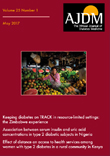Intermittent energy restriction is effective in preventing and treating diabetes
*Corresponding Author:
Received: 29-Mar-2023, Manuscript No. AJDM-23-97647; Editor assigned: 31-Mar-2023, Pre QC No. AJDM-23-97647 (PQ); Reviewed: 14-Apr-2023, QC No. AJDM-23-97647; Revised: 19-Apr-2023, Manuscript No. AJDM-23-97647 (R); Published: 26-Apr-2023
Introduction
Glucose is the body’s primary fuel source in the non-fasting state. Within the first 12-24 hours of fasting, the human body attempts to break down glycogen stores in the liver and skeletal muscles to maintain blood sugar levels. It is stimulated by glucagon, an endogenous hormone secreted by the alpha cells of the islets of Langerhans in the pancreas. After 12-24 hours, the body’s glycogen stores are often depleted. It then relies on the breakdown of fatty acids (lipolysis) to make energy. Triglycerides are broken down into glycerol and fatty acids by hormone-sensitive lipases whose activity is enhanced by glucagon, epinephrine and cortisol. The fatty acids are then transported to the liver, where they undergo beta-oxidation in mitochondria to acetyl coenzyme A.
Acetyl coenzyme A is converted into acetoacetate and beta-hydroxybutyrate (ketone bodies) through a process called ketogenesis. This is important because insulin is deficient in type 1 diabetes and to a lesser extent in type 2 diabetes.
Description
Insulin deficiency, along with elevated plasma glucose levels, can lead to excessive ketone body production. These form a key feature of diabetic ketoacidosis. Plasma that can be used to diagnose fasting glycemia (pre-diabetes) or diabetes in the absence of insulin or insulin resistance because fasting gluconeogenesis is unregulated and unable to transport glucose into cells Glucose levels rise.
Intermittent fasting, also known as Intermittent Energy Restriction (IER), is a common diet that alternates between generous eating and calorie restriction. Studies have shown that IF has short-term and long-term health benefits beyond improving weight loss. In other words, IF regularly entails total or partial restriction of energy within a defined short period of time. Its principle is to take regular breaks from your diet to create energy deficits and improve your metabolism. They say it may lead to a lower risk of metabolic disease and lower insulin resistance.
Intermittent fasting is said to affect metabolic regulation through modifiable lifestyle, circadian biology, and effects on gut microbiota. It has been shown that the level varies by the time of day and decreases towards night. The mechanisms behind this diurnal variation in insulin sensitivity are still unclear, but involve alterations in metabolism and free fatty acid availability. Elimination of evening and night energy intake has been shown to synchronize food intake with effective postprandial hormone release, improve circadian clock gene expression, reprogram molecular mechanisms of energy metabolism, and regulate body weight, it will be improved. As with medical guidelines for managing therapeutic IF in DM patients, studies on the safety and benefits of intermittent fasting in DM patients are minimal also affects potential risks. Anti-diabetic drugs such as metformin, acarbose, thiazolidinediones, GLP-1RA, and dipeptidyl peptidase 4 inhibitors are glucose dependent and generally carry low risk of hypoglycemia.
Conclusion
As such, these drugs typically do not require dose adjustments in people participating in intermittent fasting. Studies have shown that intermittent energy restriction is effective in preventing and treating prediabetes and diabetes, and significantly improves metabolic and cardiovascular biomarkers in people with diabetes. More evidence is needed before it can be incorporated into established guidelines of record. Most diabetics who choose IF for any reason can be educated about the pros and cons of achieving their goals and managing glycemic control. Extensive research is needed on clinical outcomes in DM patients.
Acknowledgement
None.
Conflict of Interest
The author has nothing to disclose and also state no conflict of interest in the submission of this manuscript.





